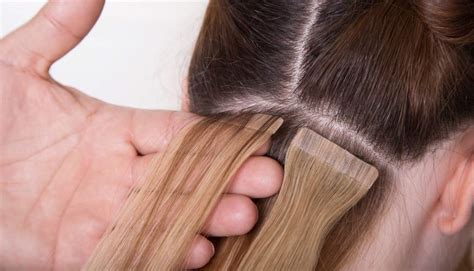Introduction
Extensions, once hailed as a miraculous solution for achieving long, luscious locks, have come under scrutiny lately. As more and more women report hair thinning and damage after using extensions, the question arises: Can extensions really damage your hair? In this comprehensive guide, we’ll explore the science behind extensions thinning hair, its prevalence, causes, and preventive measures.

The Prevalence of Extensions Thinning Hair
According to the American Hair Loss Association, approximately 30% of women who wear extensions experience some degree of hair thinning. This number is even higher (40%) among women with naturally fine or weak hair.
Causes of Extensions Thinning Hair
Several factors contribute to hair thinning caused by extensions:
- Tension and weight: The weight and tension of the extensions can pull on the hair shaft, leading to breakage and thinning.
- Chemical damage: The adhesives and chemicals used to attach extensions can irritate the scalp and damage hair strands.
- Poor technique: Improper installation and removal of extensions can also cause excessive hair loss.
Type of Extensions and Hair Thinning
Not all extensions are created equal when it comes to hair damage. Here’s a breakdown of different types:
| Extension Type | Risk of Thinning |
|---|---|
| Clip-ins | Low |
| Tape-ins | Medium |
| Fusion | High |
| Sew-ins | Medium to high |
Prevention and Care
To avoid hair thinning from extensions, follow these preventative tips:
- Choose clip-ins or tape-ins: These extensions are less damaging than fusion or sew-ins.
- Get regular professional maintenance: Have your extensions removed and reapplied regularly to prevent tangling and buildup.
- Use gentle products: Avoid using harsh shampoos and conditioners that can strip hair of natural oils.
- Limit heat styling: Excessive heat from blow dryers and flat irons can further damage weakened hair.
Can Extensions Cause Permanent Hair Loss?
In most cases, hair thinning caused by extensions is temporary and reversible. However, in extreme cases, prolonged or severe tension and chemical damage can lead to permanent hair loss.
Alternatives to Extensions
If you’re concerned about extensions thinning hair, consider these alternatives:
- Hair toppers: These are small, clip-on pieces that can add volume and length to thinning areas.
- Keratin treatments: These treatments can strengthen and thicken hair, reducing the need for extensions.
- Low-maintenance hairstyles: Short, layered cuts or styles that require minimal styling can help protect hair from damage.
Frequently Asked Questions
-
Can I wear extensions if I have fine hair?
– Yes, but choose lightweight clip-ins or tape-ins and limit wear time. -
How often should I remove and reapply tape-in extensions?
– Every 4-8 weeks. -
Can extensions worsen existing hair loss?
– Yes, if the extensions are installed incorrectly or worn for extended periods. -
What are the signs of hair thinning caused by extensions?
– Brittle hair, breakage, receding hairline, or bald patches.
Conclusion
Extensions can be a great way to achieve fuller, longer hair. However, it’s crucial to be aware of the potential risks of hair thinning. By following the preventive measures outlined in this guide, you can minimize the chances of damage and enjoy beautiful extensions without compromising your natural hair health.
